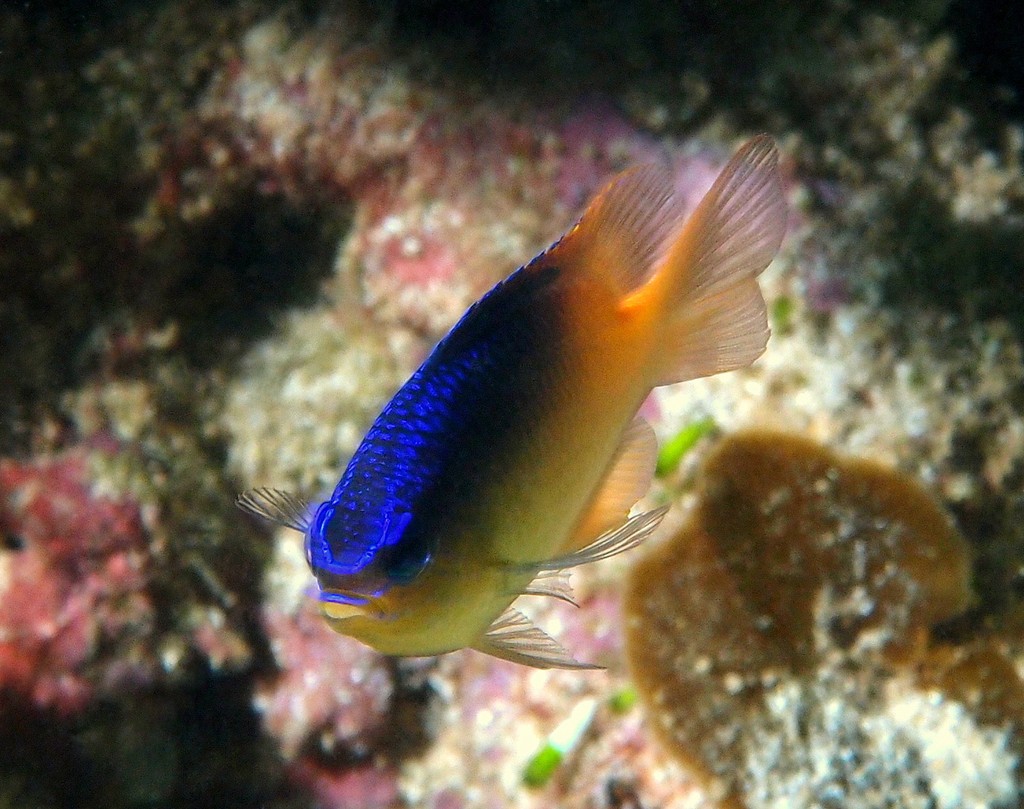CHRYSIPTERA CAESIFRONS - (ALLEN, ERDMANN & KURNIASIH, 2015)
Actinopterygii (Gigaclass) > Actinopteri (Class) > Teleostei (Subclass) > Blenniiformes (Order) > Pomacentridae (Family) > Pomacentrinae (Subfamily) > Chrysiptera (Genus)
Poisson demoiselle à dos gris, Grey Damsel, Greyback Damsel, King Damselfish,
Description
Dorsal spines (total): 13; Dorsal soft rays (total): 12-14 (usually: 13); Anal spines: 2; Anal soft rays: 12-14 (usually: 13); Pectoral fin rays: 16-18 (usually: 17); Principal caudal rays: 15; Branched-caudal rays: 13; Upper and lower accessory-caudal rays: 4-5 (4-6); Gill rakers on first branchial arch: 4-6 + 11-13, total rakers: 16-19 (usually: 17-18); Lateral-line scales (tubed): 16-18 (usually: 17); Vertical scale rows: 27-28 (usually: 27); Scales above lateral-line to base of middle dorsal spines: 1.5; Scales below lateral line to anus: 9; Tubed lateral-line scales ending below anterior soft rays of dorsal fin; Often 1-2 pitted or pored scales immediately posterior to last lateral-line scale; A series of 7-9 (usually: 7) pored or pitted scales mid-laterally on caudal peduncle to caudal base. Body depth: 2.5 (2.3-2.6) in SL; Maximum body width: 2.3 (2.2-2.6) in depth. Max. length: 5.0 cm SL. Depth range: 1 - 8 m.
Distribution
Western Pacific: Halmahera (eastern Indonesia) east to New Ireland (Papua New Guinea) and Vanuatu, south to Queensland (Australia) and New Caledonia.
Biology
The habitat consists of rocky substrates, frequently close to shore, often in gullies just below the surge zone. It generally occurs solitarily or in small, loose groups.
Similar species
Chrysiptera rex (Snyder, 1909) - Reported from Eastern Indian Ocean, western Pacific: Vietnam, Malaysia and Indonesia east to Philippines, north to Taiwan and Ryukyu Islands (Japan).
Chrysiptera chrysocephala (Manica, Pilcher & Oakley, 2002) - Reported from Western Pacific: South China Sea and Gulf of Tomini (Sulawesi, Indonesia).
Poisson demoiselle à dos gris, Grey Damsel, Greyback Damsel, King Damselfish,
Description
Dorsal spines (total): 13; Dorsal soft rays (total): 12-14 (usually: 13); Anal spines: 2; Anal soft rays: 12-14 (usually: 13); Pectoral fin rays: 16-18 (usually: 17); Principal caudal rays: 15; Branched-caudal rays: 13; Upper and lower accessory-caudal rays: 4-5 (4-6); Gill rakers on first branchial arch: 4-6 + 11-13, total rakers: 16-19 (usually: 17-18); Lateral-line scales (tubed): 16-18 (usually: 17); Vertical scale rows: 27-28 (usually: 27); Scales above lateral-line to base of middle dorsal spines: 1.5; Scales below lateral line to anus: 9; Tubed lateral-line scales ending below anterior soft rays of dorsal fin; Often 1-2 pitted or pored scales immediately posterior to last lateral-line scale; A series of 7-9 (usually: 7) pored or pitted scales mid-laterally on caudal peduncle to caudal base. Body depth: 2.5 (2.3-2.6) in SL; Maximum body width: 2.3 (2.2-2.6) in depth. Max. length: 5.0 cm SL. Depth range: 1 - 8 m.
Color
Generally pale yellow to whitish with blue (young fish) or dark blue-grey (adult fish) region encompassing snout, upper head and adjacent anterodorsal portion of body and spinous dorsal fin; Small blackish spot at uppermost rear edge of operculum near origin of lateral line; Each scale of suborbital, preopercle, and opercle with small blue spot; Each body scale with 1-2 small blue spots, generally darker on anterior half of body; Young fish with scattered neon blue spots on dark blue forehead and snout; Fins (except dark blue or greyish spinous dorsal) semitranslucent with pale yellow to whitish hue except for pair of submarginal blue stripes on spinous dorsal fin.
Etymology
Chrysiptera: from Greek, chrysos = golden + from Greek, pteron = fin, wing. Referring to yellow caudal fin and/or yellowish pectoral and ventral fins of Glyphisodon azureus Cuvier, 1830 (= Chrysiptera cyanea (Quoy & Gaimard, 1825)).
caesifrons: from Latin, caesius = blue-grey + from Latin, frons = forehead or brow. In reference to its distinguishing colour pattern. The specific name means "bluish-grey forehead”.
Original description: Chrysiptera caesifrons Allen, Erdmann & Kurniasih, 2015 - Type locality: Ayau Kecil Island, 00° 21.342’S, 130° 58.648’E, Ayau Atoll, Raja Ampat Islands, West Papua Province, Indonesia, 1.5–2.0 m, clove oil, M. Erdmann & G. Allen, 17 October 2014.
Generally pale yellow to whitish with blue (young fish) or dark blue-grey (adult fish) region encompassing snout, upper head and adjacent anterodorsal portion of body and spinous dorsal fin; Small blackish spot at uppermost rear edge of operculum near origin of lateral line; Each scale of suborbital, preopercle, and opercle with small blue spot; Each body scale with 1-2 small blue spots, generally darker on anterior half of body; Young fish with scattered neon blue spots on dark blue forehead and snout; Fins (except dark blue or greyish spinous dorsal) semitranslucent with pale yellow to whitish hue except for pair of submarginal blue stripes on spinous dorsal fin.
Etymology
Chrysiptera: from Greek, chrysos = golden + from Greek, pteron = fin, wing. Referring to yellow caudal fin and/or yellowish pectoral and ventral fins of Glyphisodon azureus Cuvier, 1830 (= Chrysiptera cyanea (Quoy & Gaimard, 1825)).
caesifrons: from Latin, caesius = blue-grey + from Latin, frons = forehead or brow. In reference to its distinguishing colour pattern. The specific name means "bluish-grey forehead”.
Original description: Chrysiptera caesifrons Allen, Erdmann & Kurniasih, 2015 - Type locality: Ayau Kecil Island, 00° 21.342’S, 130° 58.648’E, Ayau Atoll, Raja Ampat Islands, West Papua Province, Indonesia, 1.5–2.0 m, clove oil, M. Erdmann & G. Allen, 17 October 2014.
Distribution
Western Pacific: Halmahera (eastern Indonesia) east to New Ireland (Papua New Guinea) and Vanuatu, south to Queensland (Australia) and New Caledonia.
Biology
The habitat consists of rocky substrates, frequently close to shore, often in gullies just below the surge zone. It generally occurs solitarily or in small, loose groups.
Similar species
Chrysiptera rex (Snyder, 1909) - Reported from Eastern Indian Ocean, western Pacific: Vietnam, Malaysia and Indonesia east to Philippines, north to Taiwan and Ryukyu Islands (Japan).
Chrysiptera chrysocephala (Manica, Pilcher & Oakley, 2002) - Reported from Western Pacific: South China Sea and Gulf of Tomini (Sulawesi, Indonesia).
Last update: 23, January 2022.
